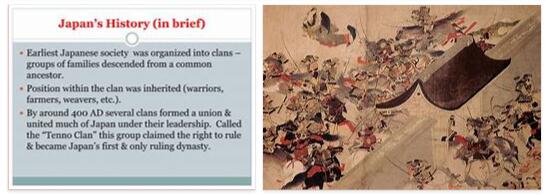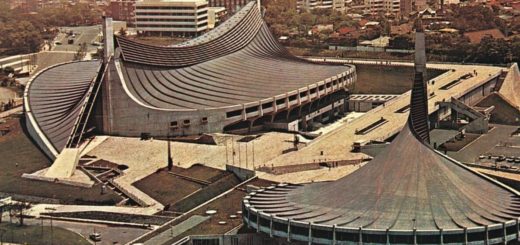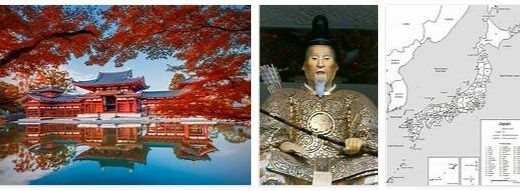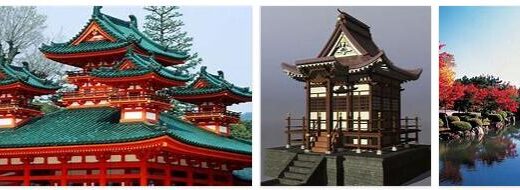Japan Brief History Part III
The rapid process of nationalization of the Japanese people played in favor of the Meiji oligarchy, facilitated by the use of collective stereotypes: the identification between nation and race, the revival of the emperor as a ‘descendant of an uninterrupted divine line’, the priority defense of Japan to achieve equal dignity with Western powers. The economic transformation was completed in 1881-85, a time when modern state-owned industries were sold at low prices to businessmen. With this decision, the government laid the foundations for the development of the zaibatsu, concentrations of family-controlled financial, industrial and commercial capital that would become the giants of the Japanese economy. In the social field, some values of Confucian ethics (loyalty and obedience, filial piety, social harmony) were reaffirmed by the imperial edict on education (1890), but above all with a widespread organization of consent. The first government on a Western model was launched in 1881: according to the Constitution (1889), ‘given’ by the emperor to his subjects, the supreme power belonged to the sovereign, whose person was “sacred and inviolable”; the ministers were accountable for their government action to the emperor and not to Parliament.
Expansionism and economic development
Once the capitalist system was consolidated, a process of expansion was initiated. In 1894-95 Japan defeated China; with the Treaty of Shimonoseki he obtained Formosa, the recognition of his interests in Korea (until now a tributary state of China) and a war indemnity that allowed him in 1897 to adopt the gold standard. After having participated (1900) in the expedition to China against the Boxers, in 1904-05 Japan, thanks to the recognition of power that came to him from the alliance signed with Great Britain (1902), faced a victorious war with Russia. Conquered Port Arthur in the Liaodong Peninsula of China, with the Treaty of Portsmouth also obtained the southern half of Sahalin Island. In 1910 Korea was annexed.
Having entered the war in 1914 alongside the Entente powers, during the years of the World War, Japan, thanks to its penetration into Asian markets and supplies to allies, quadrupled its industrial production and exports and was able to build a fleet transoceanic. At the Versailles Peace Conference, however, the only tangible result was the mandate on the former German Pacific islands; the containment of Japanese expansionism implemented by the other powers was confirmed in 1922 at the Washington Conference, when the Western powers imposed restrictions on its military tonnage on Japan Internally, economic development had initiated profound transformations in society. The creation of new industries favored urbanization; the lesser control over the workers, consequent to the need to increase production, allowed the foundation of the first political and trade union organizations of the proletariat; the urban middle classes turned to liberal demands. It was a brief parenthesis: the ruling class, worried about the easing of internal controls and the evolution of the international situation (Soviet revolution, anti-Japanese protests and the founding of the Communist Party in China), soon resorted to repressive measures.
The ‘fascism of the imperial system’
In 1925 the Parliament granted universal male suffrage, but at the same time approved the Chian ijihō, a law for the maintenance of public order which made the defense of the kokutai (national system), a vague term that lent itself to any repressive interpretation, the foundation of political activity. On the basis of the Chian ijihō, Marxist students were first persecuted (1925), then the militants and leaders of the Communist Party (1928) and finally, in the 1930s, liberals from the world of culture. On the imperial throne, the death of Meiji (1912) was succeeded by his son Yoshihito (he was Taishō), replaced in 1921 by the regency of Hirohito, emperor in 1926. The reign of Hirohito (was Shōwa) saw the affirmation of a power block formed by the civil and military bureaucracy, by the zaibatsue from the imperial court who imposed a totalitarian regime until 1945. The tennōsei fashizumu (fascism of the imperiale) was characterized compared to the Italian and German cases by the absence of the dictator, whose role was replaced by the charisma of the emperor.
According to THENAILMYTHOLOGY, the consolidation of the regime was matched by a more pronounced imperialist push. In 1931 Japan invaded Manchuria and established the puppet regime of Manchukuo there; in 1937 it invaded China and in 1940 it occupied southern Vietnam ( fig. 2 ). The US tried to curb the Japanese expansion and proclaimed an economic embargo to the exclusion of petroleum products. The response of Tokyo, which, having left the League of Nations in 1940, had signed the tripartite pact with Italy and Germany, substantiated itself in the attack on the naval base of Pearl Harbor without the declaration of war being notified to Washington (December 7, 1941). After the initial successes (occupation of the Dutch Indies, the Philippines and Burma), the fate of the conflict turned against Japan, who on 15 August 1945, after the declaration of war by the USSR (8 August) and the atomic bombings of Hiroshima and Nagasaki (6 and 9 August), accepted the unconditional surrender, signed on 2 September.



